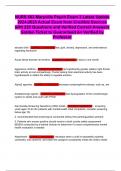NURS 663 Maryville Psych Exam 3 Latest Update
2024-2025 Actual Exam from Credible Sources
with 220 Questions and Verified Correct Answers
Golden Ticket to Guaranteed A+ Verified by
Professor
abused child - CORRECT ANSWER: fear, guilt, anxiety, depression, and ambivalence
regarding disclosure
Acute stress disorder dx timeline - CORRECT ANSWER: 3 days to one month
aggressive children - CORRECT ANSWER: had significantly greater relative right frontal
brain activity at rest comparitively. Frontal resting brain electrical activity has been
hypothesized to reflect the ability to regulate emotion
Alpha2 agonists - CORRECT ANSWER: decrease norepinephrine release, such as, are
Antiadrenergic agents - CORRECT ANSWER: treat dysregulation of the noradrenergic
system in adults and youth with PTSD
Ask Suicide-Screening Questions (ASQ) toolkit - CORRECT ANSWER: 1. screening
youth ages 10-24 (for patients with mental health chief complaints, consider screening
below age 10).
2. recommended that screening be conducted without the parent/guardian present.
3. Patients who screen positive should receive a brief suicide safety assessment
(BSSA) conducted by a trained clinician to determine if a more comprehensive mental
health evaluation is needed
Attachment - CORRECT ANSWER: --develops when a child is repeatedly soothed,
comforted, and cared for, and when the caregiver consistently meets the child's needs
,--creates love and trust others, to become aware of others' feelings and needs, to
regulate his or her emotions, and to develop healthy relationships and a positive self-
image
Attachment Neuropsych - CORRECT ANSWER: 1. right hemispheres forge neural
connections between infants subcortical, bodily-based affective states with conscious
emotional states in the higher brain regions of the right hemisphere;
2. these circuits are vital to emotional processing, empathy and development of self
3. Right hemisphere and limbic system develop rapidly during the first year and
responsible for habitual responses to stress
BCA 0.05 % - CORRECT ANSWER: thought, judgment, and restraint are loosened and
sometimes disrupted.
BCA 0.1 to 0.15 - CORRECT ANSWER: In most states, legal intoxication ranges
BCA 0.1% - CORRECT ANSWER: voluntary motor actions usually become perceptibly
clumsy
BCA 0.2 % - CORRECT ANSWER: the function of the entire motor area of the brain is
measurably depressed, and the parts of the brain that control emotional behavior are
also affected
BCA 0.3% - CORRECT ANSWER: a person is commonly confused or may become
stuporous
BCA 0.4 to 0.5 % - CORRECT ANSWER: the person falls into a coma. At higher levels,
the primitive centers of the brain that control breathing and heart rate are affected, and
death ensues secondary to direct respiratory depression or the aspiration of vomitus.
Benzo immediate risks - CORRECT ANSWER: large margin of safety when taken in
overdoses
lethal dose to effective dose is about 200 to 1; minimal respiratory depression.
,Benzo MOA - CORRECT ANSWER: Stimulation of the inhibitory GABAergic activity,
either by endogenous ligands or _______ or results in sedation, amnesia and ataxia,
while attenuation of the GABAergic system leads to arousal, anxiety, restlessness,
insomnia and exaggerated reactivity
Benzo w/d mood and cognition - CORRECT ANSWER: Anxiety, apprehension,
dysphoria, pessimism, irritability, obsessive rumination, and paranoid
ideation
Benzo w/d perception - CORRECT ANSWER: Hyperacusis, depersonalization, blurred
vision, illusions, and hallucinations
Benzo w/d phys s/sx - CORRECT ANSWER: Tachycardia, elevated blood pressure,
hyperreflexia, muscle tension, agitation/motor
restlessness, tremor, myoclonus, muscle and joint pain, nausea, coryza, diaphoresis,
ataxia,
tinnitus, and grand mal seizures
Benzo w/d sleep - CORRECT ANSWER: Insomnia, altered sleep-wake cycle, and
daytime drowsiness
Benzo w/d timeline - CORRECT ANSWER: onset of withdrawal symptoms usually
occurs 2 to 3 days after the cessation of use, but with long-acting drugs, the latency
before onset can be 5 or 6 days
benzodiazepines - CORRECT ANSWER: no controlled trials supporting use in children
benzodiazepines w/d - CORRECT ANSWER: anxiety, dysphoria, intolerance for bright
lights and loud noises, nausea, sweating, muscle twitching, and sometimes seizures
Benzos w/d states - CORRECT ANSWER: recurrence: return of the original anxiety sx
, rebound: worsening of the original anxiety sx rue withdrawal emergence of new sx
biological factors addiction - CORRECT ANSWER: Genetic vulnerability (accounts for
40-60%). Birth.
Adoption.
Diet and nutrition.
Mental disorders.
Disease and illness or other medical disorder. Withdrawals and cravings.
biopsychocial model addiction - CORRECT ANSWER: inherited and an induced
biological component to addictive disorders but also psychological-behavioural and
social-cultural factors that have a role in the cause, course, and outcome of substance
dependence
biopsychosocial advantages - CORRECT ANSWER: Accounts complicating,
contributing factors
Encourages a complex yet individualized understanding
Encourages a broader treatment perspective.
Involve addressing more than one problem at a time.
Changes at one level influence the other levels, therefore interventions at one level also
influence other levels.
It is comprehensive.
It is the model most widely endorsed by treatment researchers because it can most
adequately explain the intricate nature
biopsychosocial disadvantages - CORRECT ANSWER: Emphasis may be placed on
one aspect of the model without a solid integration of the three aspects.
It is difficult to provide interventions on all three aspects at the same time.
Some factors, such as risk and protective factors, cannot be changed.
Its eclectic freedom has at times been accused of leading to anarchic thinking.




